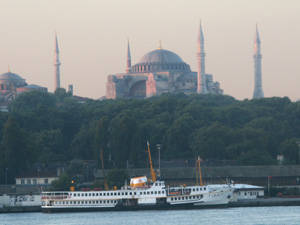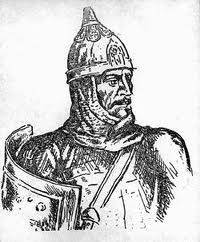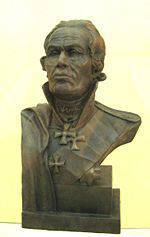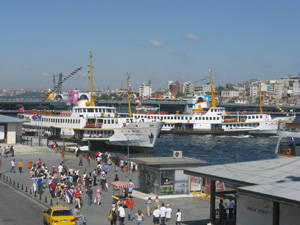Straits of sticking - from Byzantium to the present day
 In a few months the world will celebrate the 75 anniversary of the Montreux Convention, which determined the status of the Black Sea straits of Bosporus and Dardanelles. The Montreux Convention is almost the only international treaty that has existed without amendments all this time. However, since 1991, Turkey has been attempting to replace the convention with intra-Turkish laws and to make the international straits with its internal waters. It is easy to understand that in case of passage of the straits under Turkish control with a permitting system for civil and military courts to pass through them, the Russian economy will suffer enormous damage, and the security of the Russian Federation will be threatened.
In a few months the world will celebrate the 75 anniversary of the Montreux Convention, which determined the status of the Black Sea straits of Bosporus and Dardanelles. The Montreux Convention is almost the only international treaty that has existed without amendments all this time. However, since 1991, Turkey has been attempting to replace the convention with intra-Turkish laws and to make the international straits with its internal waters. It is easy to understand that in case of passage of the straits under Turkish control with a permitting system for civil and military courts to pass through them, the Russian economy will suffer enormous damage, and the security of the Russian Federation will be threatened. WAY FROM VARYAG TO THE GREEKS
We must not forget that the path from the Varyags to the Greeks and further to the Mediterranean Sea became the state-forming one for Russia.
The ships of the Rus passed the straits already in the 9th century. Thus, in the Life of Georgy Amastridsky it is said about the invasion of the Rus into the Byzantine city in Asia Minor Amastrid somewhere between 830 and 842 the year.
18 June 860 of the year around the 200 ships of the Rus came to the Bosphorus. We know about this campaign from Byzantine sources, among which the most valuable belong to Patriarch Photius (around 810 - after 886) - a witness and participant of this event. I note that the Rus campaign was not committed for the purpose of robbery, but above all as retribution for murder and slavery for the debts of several Rus in Constantinople.
Curious that flotilla Rus commanded Prince Askold. The same Askold, who in 844 stormed the Spanish city of Seville. The Arab historian calls him Askold al-Dir (translated from the Gothic Djur means "beast"). Two centuries later, the Kiev chronicler misunderstood something or did not hear something, and as a result, stories Russia Karamzin appeared two princes - Askold and Dir.
For us, it is important that in the 9th century the Russian prince Askold with his retinue passed at least twice through the Bosphorus and the Dardanelles.

This was followed by trips to Constantinople by the Russian princes Oleg, Igor and others. I note that these were not purely predatory raids. Several times the Russian princes concluded peace treaties with the Byzantine Empire, the main purpose of which was the rights of Russian merchants to visit the straits.
In 1204, Constantinople was treacherously captured by the Crusaders. "Warriors of Christ" went to the fourth crusade to liberate Jerusalem from the unfaithful. Instead, they staged a wild massacre of Orthodox shrines in Constantinople.
It is not difficult to guess that in the 1204 year, the Russian trade quarter was also completely destroyed.
The almost complete cessation of Russian trade in Constantinople and transit through the straits led to the economic and political extinction of Kiev.
In 1453, the Turks seize Constantinople, rename it to Istanbul and make it the capital of the Ottoman Empire. It is worth noting here that the Russian princes were powerless to render military assistance to the last Byzantine emperors, separated from Constantinople not only by sea, but also hundreds of miles of Wild Field controlled by the Tatars.
Nevertheless, in this extremely difficult situation, the Russian Church sent huge sums of money to Constantinople. For example, Metropolitan Kirill sent 1395 thousand rubles to Tsargrad only in 1396 – 20 years. (a huge sum for those times). How this money was spent is unknown, but it is obvious that the overwhelming part of it went to the needs of defense.
By the beginning of the XVI century, almost the entire Black Sea coast became the possession of the Sultan or his vassals. As a result, Russia for three and a half centuries lost access to the shores of the Black Sea.
SHADOW OF ALLAH ON EARTH
Turkish sultans called themselves the shadow of Allah on earth. The Sultan was simultaneously considered a caliph, that is, the head of all Muslims. Moscow sovereigns were not slow to give a decent response in the "ideological" war - "Moscow is the third Rome, and the fourth is not to be."
On 1656 Bright Easter, Tsar Alexei Mikhailovich, being a Christian merchant with Greek merchants, promised to free them from Turkish slavery: "God will call me to account on the day of the trial if, having the opportunity to free them, to neglect it."
Alas, the war with the Turks of Peter the Great and Anna Ioannovna did not allow Russia to go to the shores of the Black Sea. Only after the 1768 – 1774 war did Catherine II succeed in including the clause on the right of passage through the straits to the Russian merchant ships in the text of the Kaynadzhi Treaty. Yes, and these vessels had limitations in size. But, alas, the sultans, even after 1774, interpreted this article according to their whim: if they want, Russian courts will let go, if they will, they will not miss.
To return the original right of Russia to a free passage through the straits of military and commercial ships, which, as we know, Prince Askold gained by force, helped us ... General Bonaparte. His troops captured the Ionian Islands in 1797, and the following year, the "enemy of the human race" landed in Egypt. Selim III, expecting to see the French on the Bosphorus, made a tearful request for help to Emperor Paul I. December 23 1798 (January 3 1799 on the new style) in Constantinople, the Allied Russian Defense Treaty between the All-Russian and Ottoman Porto Empire was concluded. Turkey pledged to open up the straits for the Russian military fleet. "For all other nations, without exception, the entrance to the Black Sea will be closed." Thus, the treaty made the Black Sea a closed Russian-Turkish basin. At the same time, the right of Russia, as a Black Sea power, to be one of the guarantors of the shipping regime of the Bosporus and the Dardanelles was recorded.
As the saying goes, history does not tolerate the subjunctive mood, but if Turkey strictly adhered to this treaty, it would be possible to put an end to the history of the Russian-Turkish wars. After all, Sweden concluded peace with Russia in 1809, and so far has never fought. Although Europe was constantly pressured on Sweden to make it fight with the Russians.

The squadron of Admiral Ushakov, under the roar of the salute, passed the Bosphorus, greeted by crowds of Turks and even Selim III himself. However, in the autumn of 1806, incited by the Western powers, the Turks closed the straits for Russian warships and imposed serious restrictions on the passage of merchant ships. The result is the Russian-Turkish war of 1806 – 1811.
This is followed by a series of contracts (Unkjar-Iskelesii 1833 year, London 1841 and 1871 years), according to which merchant ships of all countries could freely pass through the straits, and military ships were forbidden to enter, except, of course, the ships of the Turkish fleet.
It should be noted that the Turks from 1857, selectively passed through the straits of Russian military vessels. For example, in 1858, two new 135-gun ships, the Sinop and the Tsesarevich, passed from Nikolaev to the Mediterranean. And in 1857 – 1858, six corvettes passed in the opposite direction. In 1859, the steam frigate "The Stormy" with the Grand Duke Konstantin Konstantinovich visited Istanbul, etc. However, during the Russian-Japanese war of 1904 – 1905, the Turks refused to let the ships of the Black Sea Fleet pass through the Bosphorus.
MONTREUX CONVENTION
Only in 1936, in the Swiss city of Montreux, did the more or less acceptable strait convention be concluded.
The Convention reaffirmed the principle of the right of free passage and navigation in the straits and declared free passage through the straits of merchant ships of all countries.
In peacetime, merchant ships enjoy complete freedom of passage through the straits, day and night, regardless of flag and cargo, without any formalities.
Pilotage is optional. However, at the request of the captains of ships heading to the Black Sea, pilots may be called from the relevant pilot points on the approaches to the straits.
During the war, if Turkey is not a belligerent, merchant ships, regardless of flag and cargo, will enjoy the full freedom of transit and navigation in the straits under the same conditions as in peacetime. If Turkey is a belligerent, merchant ships not belonging to a country in war with Turkey enjoy freedom of passage and navigation in the straits, provided that these ships do not render any assistance to the enemy and enter the straits only during the day.
The Convention provides for a sharp delimitation for passage through the straits of ships coastal and non-coastal to the Black Sea powers.
The passage of warships of the coastal powers declared in peacetime free, subject to certain requirements. So, only the Black Sea states are allowed to pass through the straits all types of surface ships, regardless of their armament and displacement.
Only the Black Sea states can conduct submarines through the straits in the following cases:
1) for the purpose of returning submarines built or purchased outside the Black Sea to their bases in the Black Sea, provided that Turkey will be notified in advance of the tab or purchase;
2) if repair of submarines is necessary in shipyards outside the Black Sea, provided that accurate data on this issue will be communicated to Turkey.
In both cases, the submarines must pass the straits alone, only during the day and on the surface.
Non-Black Sea states are allowed to pass through the straits ships with a displacement of up to 10 thousand tons with artillery caliber up to 203 mm inclusive.
In the case of Turkey’s participation in the war, the passage of military courts through the straits depends solely on the discretion of the Turkish government. Turkey has the right to apply this article even if it “would consider itself to be under threat of immediate military danger”.
With the outbreak of World War II, Turkey declared its neutrality. In fact, the Turkish authorities directly and indirectly helped Germany and Italy. Indeed, the battleships, cruisers and even destroyers of these countries did not pass through the straits, but only because the axes had no need for this. Italy and so did not have enough warships to counter the British fleet in the Mediterranean, and the Germans did not have their surface ships at all.
However, the German minelayers, minesweepers, PLO ships, landing craft, military transports of all kinds passed through the Bosphorus every year in 1941 – 1944. In this case, part of the artillery weapons were occasionally dismantled and stored in the holds.
Through the Danube, the ports of Romania, the straits, and then onto the German-occupied territory of Greece, to the Balkans and further to Italy and France went one of the most important communications of the Third Reich.
Did the passage of the German ships through the Straits of the Montreux Convention match? Obvious gross violations were absent, but nevertheless there was nothing to complain about. In 1941, 1942 and 1943, the Soviet embassy in Ankara repeatedly drew the attention of the Turkish Foreign Ministry to the violation of the Montreux Convention, to the inadmissibility of passing through the straits of German and other ships under the flags of the merchant fleet, but according to the information available to the embassy, “for military purposes”.
The memorandum by the Soviet ambassador Vinogradov, presented to Foreign Minister Sarjoglu 17 on June 1944, referred to a number of cases of passage through the straits of the German military and military auxiliary vessels disguised as merchant ships.
The Montreux Convention is still in force. Before 1991, the Turks were afraid of Soviet military power and more or less tolerably carried out all of its articles. The main violations of the convention were limited to the episodic passage of American cruisers and destroyers with missiles on board to the Black Sea. Moreover, the missiles could have nuclear warheads. I note that the US Navy, when entering the ports of other states, in principle does not provide information on the presence or absence of nuclear weapons on board.
At the time of the conclusion of the convention in 1936, there were neither guided missiles, nor nuclear weapons, and the 203-mm gun was the extremely powerful ship weapon to be passed to the Black Sea. The maximum range of such weapons was 40 km, and the weight of the projectile - 100 kg. Obviously, such restrictions should be extended to modern missiles, that is, the firing range of the missiles - 40 km and the weight of the missile - no more than 100 kg.
The range of American cruise missiles "Tomahawk" - about 2600 km. Such missiles are launched from torpedo tubes of submarines and silo launchers of Ticonderoga type cruisers and destroyers of the Orly Bird and Sprujens types, etc. In the course of two wars with Iraq and aggression in Yugoslavia, US surface ships and submarines made mass launches Tomahawk missiles. Moreover, in most cases, these missiles ensured the destruction of point objects - the positions of ballistic and anti-aircraft missiles, underground bunkers, bridges, etc.
If compounds of the US ships with Tomahawk missiles enter the Black Sea, then the entire territory of the Russian Federation to the Urals inclusive will be in the radius of action. Even without the use of nuclear warheads, Tomahawks can disable most of our rocket launchers, headquarters and other infrastructure.
Istanbul, as in former times, is the largest trade and transit hub at the intersection of strategic sea lanes.
Photo by the author
HOW I WANT, SO AND FAMILY

After the collapse of the USSR and the coming to power of the Yeltsin government, Turkish rulers began to unilaterally try to change the articles of the Montreux Convention. So, 1 July 1994, Turkey introduced new shipping regulations in the straits. According to them, the Turkish authorities received the right to suspend navigation in the straits during construction work, including underwater drilling, fire extinguishing, research and sports activities, acts of rescue and assistance, measures to prevent and eliminate the effects of marine pollution, operations to investigate crimes and accidents and in other similar cases, as well as the right to introduce compulsory pilotage where they deem necessary.
Ships over 200 m in length must pass through the straits during daylight hours and always with a Turkish pilot. The Turkish authorities have been granted the right to inspect merchant ships, primarily tankers, for compliance with national and international operational and environmental standards. Fines and other sanctions were imposed for non-compliance with these standards - up to sending the vessel back, restrictions on berthing (refueling) in adjacent ports, etc.
As early as February 1996, the issue of the illegitimacy of the introduction of the Regulation on shipping in the straits by Turkey was raised at a meeting of the Committee on Economic, Commercial, Technological and Environmental Issues of the Parliamentary Assembly of the Black Sea Economic Cooperation. For example, as a result of the introduction of regulations from 1 July 1994 of the year to 31 of December 1995, there were 268 cases of unreasonable delays of Russian ships, which caused 1553 to lose hours of operating time and damage in the amount of over $ 885 thousand, not counting lost profits lost contracts and late charges.
In October, the 2002 of the year in Turkey adopted a new instruction on the application of the rules of navigation in the straits. Now large vessels should pass the Bosphorus only during daylight hours and at a speed of no more than 8 nodes. I note that both banks of the Bosphorus are well lit all night. According to experts, vessels with a “dangerous cargo” under the new rules should warn the Turkish authorities about the passage of the Bosporus in 72 hours. From Novorossiysk to the Bosphorus - 48 hours go, from Odessa - even less. If the preliminary application arrived at the wrong time, there will be inevitable downtime, delays, increased transportation costs.
The Turkish authorities complain that 136 ships are used to navigate the straits every day, of which 27 are tankers.
I note that this is not so much, and the interval between the vessels going in both directions is 21 a minute.
In September 2010, the windows of our ship went to the Bosphorus, and for five days I was convinced that transit vessels through the Bosphorus (including Turkish) go quite rarely, sometimes for several hours no one is visible. In any case, in 1980-ies the movement of ships on the Neva, Volga and Volga-Balt and them. Moscow was an order of magnitude more intense, which I also personally observed.
Only the Turks themselves create an emergency situation on the Bosporus. Here, for example, 3 in November 1970 of the year in the Dardanelles strait in the fog on the cruiser "Dzerzhinsky" began to move Turkish cargo ship. The cruiser gave way to the Turk, but he moved onto the cruiser and rammed him into the port side in the 18 – 20 area of the frame. After that, the Turkish cargo ship “Trave” left the collision site.
It may be objected that this is supposedly an isolated case. So ask our naval sailors if there has been at least one incident of the passage of our large warships through the Bosphorus without the escort of Turkish military and suspicious civilian boats winding like flies? These boats passed by our ships at a distance of several meters. According to the stories of the sailors, at least two of these boats were killed under the bows of the ships. Here, for example, 15 March 1983, the heavy aircraft carrier cruiser Novorossiysk entered the Bosphorus. In the strait, he was accompanied by three Turkish rocket boats, three large patrol boats, and two reconnaissance vessels with hulls of black and white colors, for which our sailors called them the White Cardinal and the Black Cardinal.
In 2003, the Turkish boat tried to prevent the passage of the large landing ship "Caesar Kunikov" and demanded to stop at VHF. Captain 2 of the rank of ship Sergei Sinkin replied: "Do not interfere with my actions." Machine gunners turned around on deck - the marines, the crew on alert took combat positions.
Dozens of small passenger ships, such as our Moskvich river tram, interfere with shipping in the Bosphorus, which cross the fairway in the center of Istanbul in complete disorder. A natural question arises: who is stopping anyone - international shipping to these boats or vice versa? According to experts, almost all the clashes in recent years have occurred with the ships of the Turkish coastal fleet, which run across the straits, but the Turkish side is trying to keep quiet about it.
And why would the Turkish authorities not to streamline the movement of river trams? By the way, in Istanbul there are already two bridges over the Bosphorus and a third is being built, and in 2009, the railway tunnel with 11 (!) High-speed train lines was to be commissioned. Now they want to finish it by the end of this year.
AGREEMENTS SHOULD BE FOLLOWED
In parallel with the rant about the complexity of the situation on the Bosphorus, the Turkish authorities built dozens of small ferries that are worn in all directions at speeds of 30 – 40 knots. All over the world, they are trying to build large ferries with a speed of 6 – 8 nodes. With such a speed in 8 – 10 minutes it is quite possible to cross the Bosphorus. It is not difficult to guess that high-speed ferries are potential tank landing ships. Of course, the Turks are free to build them, but is there a place for these “meteors” in the Bosporus?
Traffic control in the Bosphorus remains at an archaic level. Meanwhile, according to research carried out by the Lloyd's Register Navigation Safety Technologies Department, a modern radar control system can increase the throughput of the straits by several times.
Finally, the Turks grossly violate the Montreux Convention, appropriating the right to search for foreign courts. Here, for example, in 1997, the Republic of Cyprus wished to purchase the C-300 anti-aircraft missile system in the Russian Federation, which in those years was a completely routine affair. And the Russians sold C-300, and the Americans supplied their similar Patriot complex to dozens of countries, including the Mediterranean. But then the Turkish government announced that it would seize courts carrying C-300 to Cyprus by force, and even conducted an illegal search of several vessels flying the flags of Ukraine, Egypt, Ecuador and Equatorial Guinea in the straits.
I note that the C-300 to Cyprus was easy to deliver from the Baltic Sea under escort of Russian and Greek warships. But the Yeltsin government did not go at all and silently observed how the Turks defiantly wipe their feet about the Montreux Convention.
By the way, and on other violations of the convention, I am not aware of the protests of the Russian government. Maybe one of our diplomats complained, maybe he made a face. But is such a reaction worthy of our power? The Russian Federation has enough leverage, from economic to military, to remind Turkey of the ancient postulate - Pacta sunt servanda - the agreements should be respected.
Information